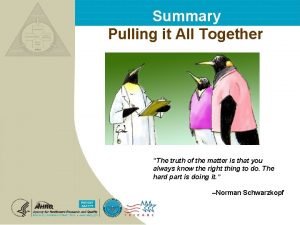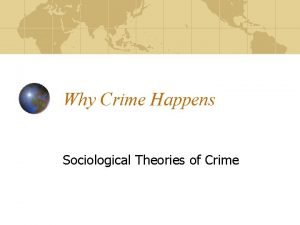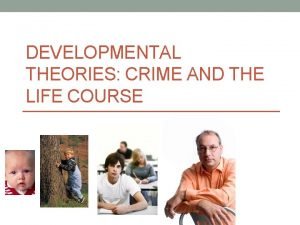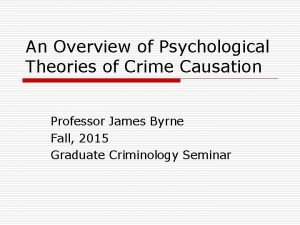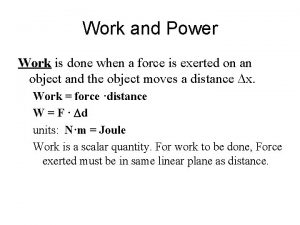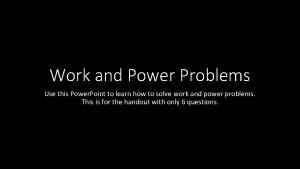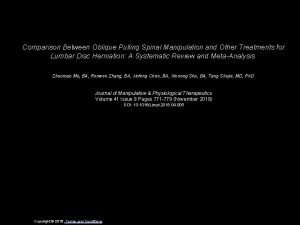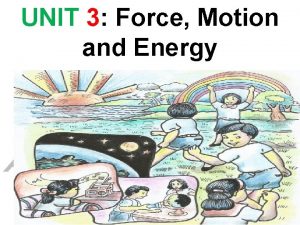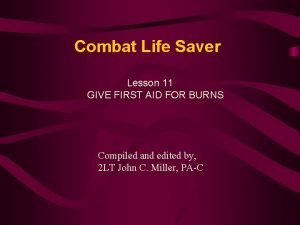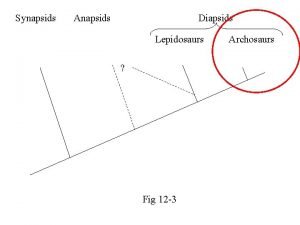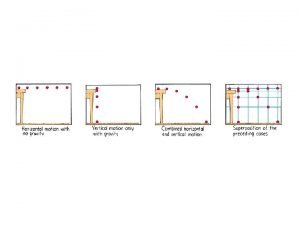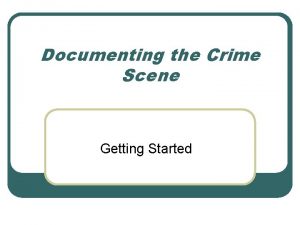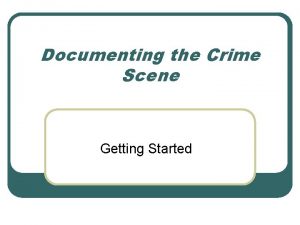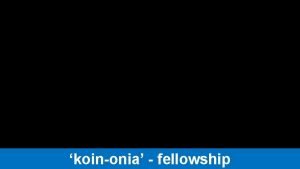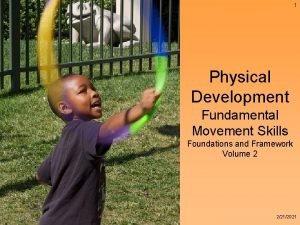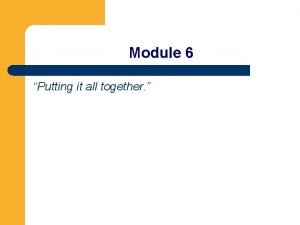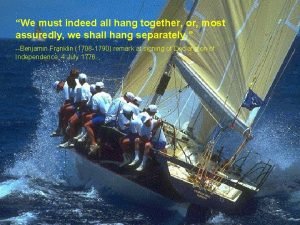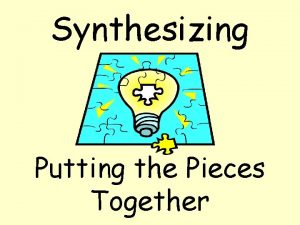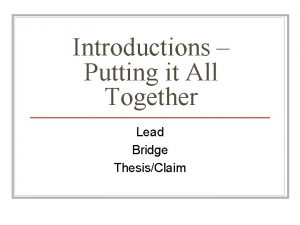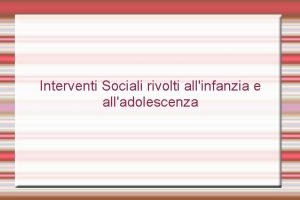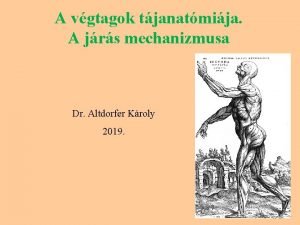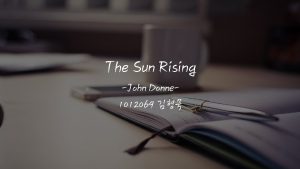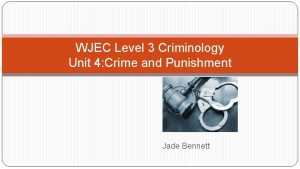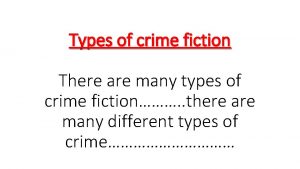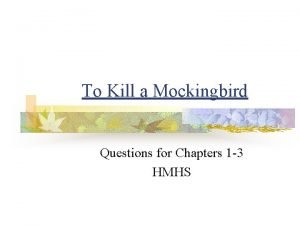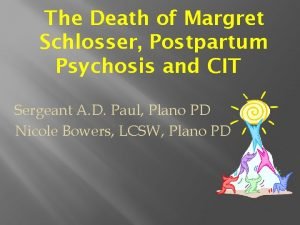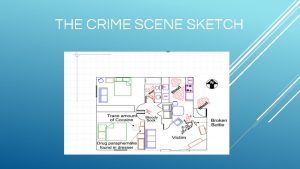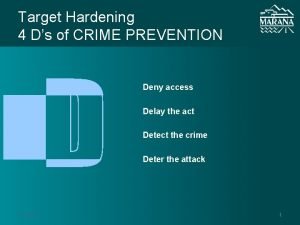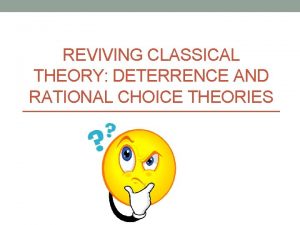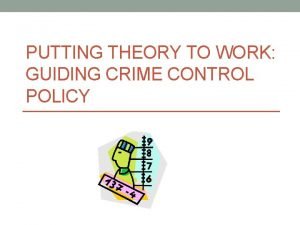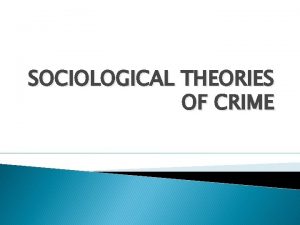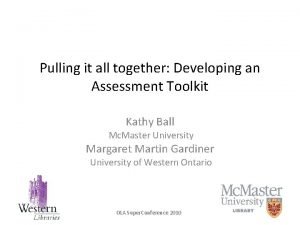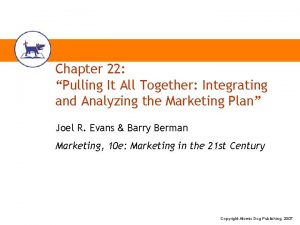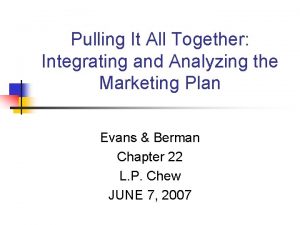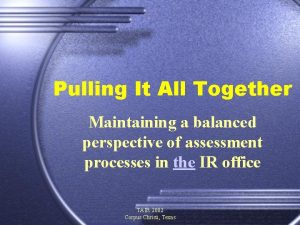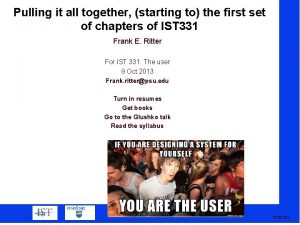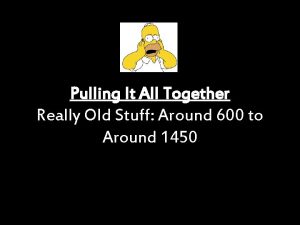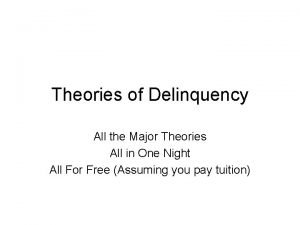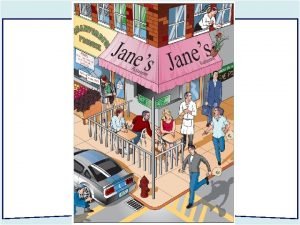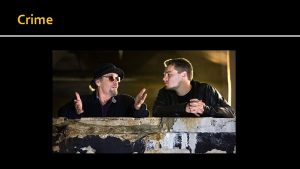PULLING IT ALL TOGETHER INTEGRATED THEORIES OF CRIME










































































- Slides: 74

PULLING IT ALL TOGETHER: INTEGRATED THEORIES OF CRIME

Doing Theoretical Integration Up to now, we have examined many micro- and some macrolevel theories including the three major theories in contemporary criminology • 1. Learning 2. Anomie/strain 3. Control • Each of the above theories had some empirical support and was able to explain some of the variation in crime • Thus, some have argued that we should integrate theories To integrate theories is to formulate relationships among them • • Do not just list the variables from the different theories; rather, describe the relationships among the variables

Doing Theoretical Integration • Most common way to integrate theories is by using the “end-to- end” approach • Describe the temporal ordering between variables so that the dependent variables of some theories constitute the independent variables of others • Example: strain joining of a delinquent subculture crime • There are multiple integrated theories • Lombroso’s work combining psychological, biological, and social variables • Theories that argue there is an interaction between individual traits and the social environment • Shaw and Mc. Kay combine strain, learning, and control theories

Doing Theoretical Integration • Most integrated theories have been at the micro-level; however, a few have attempted to integrate macro-level theories • Macro-level theories try to explain crime rates in groups • One macro-level integrated theory is institutional-anomie theory • Integrates Merton’s theory and social disorganization theory

Doing Theoretical Integration • Some attempt to integrate macro- and micro-level theories • Describe how macro-level variables influence the criminal behavior of individuals • However, some oppose the integration of theories, especially Hirschi • The most common objection is that theories being integrated are based on opposing assumptions, and thus one theory would have to be substantially altered • Example: strain theory and control theory have different assumptions about criminal motivation • Argue, instead, that we should focus on the development of individual theories

Thornberry: “Toward an Interactional Theory of Delinquency” • Combines Hirschi’s social bond and differential association/learning theories using end-to-end integration • Thornberry, however, calls this theoretical elaboration and not integration • Arguing there is no requirement to resolve disputes among other theories • Weak social bonds, association with delinquent peers, and delinquent values contribute to delinquent behavior • However, he still does describe how macro-level variables may affect the micro-level variables in his theory • Draws attention to developmental processes and reciprocal effects of variables • Describes how variables in his theory change in importance over the life course and uses theory to explain career patterns in crime

Thornberry: “Toward an Interactional Theory of Delinquency” • Control theory argues delinquency emerges when the social and cultural constraints over human conduct are substantially attenuated • There is a natural impulse toward crime • Learning theory posits there are no natural impulses toward crime • Delinquent behavior must be learned through the same processes and mechanisms as conforming behavior

Thornberry: “Toward an Interactional Theory of Delinquency” Argue control and learning theories are limited in that: • 1. They rely on unidirectional rather than reciprocal causal structures 2. They are nondevelopmental, specifying causal models for only a narrow age range, usually mid-adolescence 3. They tend to assume uniform causal effects throughout the social structure

Thornberry: “Toward an Interactional Theory of Delinquency” • Interactional theory attempts to address the three limitations • The basic premise of interactional theory is that human behavior occurs in social interaction and can therefore best be explained by models that focus on interactive processes • Argues people interact with other people and institutions and that behavioral outcomes are formed by that interactive process

Thornberry: “Toward an Interactional Theory of Delinquency” • Interactional theory develops from the same intellectual tradition as the traditional theories • Asserts the fundamental cause of delinquency lies in weakening social constraints over the conduct of the individual, which allows for a much wider array of behavior • For the freedom from weakened bonds to lead to delinquency, an interactive setting in which delinquency is learned, performed, and reinforced is required

Thornberry: “Toward an Interactional Theory of Delinquency” An interactional theory must respond to two overriding issues: • 1. How are traditional social constraints over behavior weakened 2. How is the resulting freedom channeled into delinquent patterns • Interactional theory focuses on the interrelationship of six concepts: 1. Attachment to parents (control) 2. Commitment to school (control) 3. Belief in conventional values (control) 4. Associations with delinquent peers (learning) 5. Adopting delinquent values (learning) 6. Engaging in delinquent behavior

Thornberry: “Toward an Interactional Theory of Delinquency” • Model specification • Presents a causal model allowing for reciprocal relationships among the six concepts • The model below refers to the period of early adolescence from about ages 11 to 13 when delinquent careers are beginning

Thornberry: “Toward an Interactional Theory of Delinquency” Model specification of social learning variables • The specification of causal effects begins by examining three concepts of social learning theories: • 1. Delinquent peers 2. Delinquent values 3. Delinquent behavior • Traditional social learning theories specify a causal order among these variables in which: Delinquent Peers Values Behavior • However, other theoretical perspectives and empirical work has suggested reversing the causal order suggesting those who engage in delinquent behavior seek out delinquent friends • Thornberry argues that we should not focus on the unidirectional nature of this relationship and instead see it as reciprocal: Delinquent Peers Behavior

Thornberry: “Toward an Interactional Theory of Delinquency” • Model specification of social learning variables • See similar arguments with the other social learning variables • Social learning theory states: Delinquent and Delinquent Peers Values Behavior • However, other theories postulate: Delinquent and Delinquent Values Peers Behavior Values • Again, Thornberry argues there is a reciprocal effect among these concepts: Delinquent and Delinquent Peers Values Behavior

Thornberry: “Toward an Interactional Theory of Delinquency” • Model specification of social learning variables • Although each of the social learning concepts appears to have reciprocal interrelationships, the strengths of the associations between the variables and subsequent delinquent behavior are not equal during early adolescence • Beliefs that delinquent conduct is acceptable are emerging but not fully developed at this time, thus are viewed more as an effect than a cause of delinquent behavior • Beliefs are seen as being produced by delinquent peers and behavior • However, as these beliefs/values emerge they have feedback effects and further reinforce the behavior and association with delinquent peers

Thornberry: “Toward an Interactional Theory of Delinquency” Model specification of social control variables • The primary mechanisms that bond adolescents to the conventional world are: • 1. Attachment to parents 2. Commitment to school 3. Belief in conventional values • During early adolescence, family is the most salient arena for social interaction and involvement, and thus has a stronger influence on the other aspects of the youth’s life

Thornberry: “Toward an Interactional Theory of Delinquency” Model specification of social control variables • Having strong affective bonds or attachment to parents is predicted to affect four other variables: • 1. Commitment to school 2. Belief in conventional values 3. Lack of association with delinquent others 4. Lack of delinquent behavior • However, not being committed to school, having delinquent values, associating with delinquent peers, and engaging in delinquent behavior can diminish the level of attachment between parent and child because these factors are contrary to parental expectations • These behaviors suggest the child does not care about the parents’ wishes and jeopardizes the affective bond between the parents and child

Thornberry: “Toward an Interactional Theory of Delinquency” • Model specification of social control variables • Belief in conventional values is involved in two different causal loops: 1. It strongly affects commitment to school and then is affected by commitment to school l 2. It affects associations with delinquent peers l • Want to do well in school and when do well, it reinforces beliefs in conventional values If do not believe in conventional values, more apt to associate with delinquent others, who then further attenuate their beliefs in conventional values Belief in conventional values does not have a particularly strong impact on the initiation of delinquent behavior l Not affected by delinquent behavior, nor related to delinquent values l Appears to be quite invariant regardless of class or delinquency status

Thornberry: “Toward an Interactional Theory of Delinquency” Model specification of social control variables • Commitment to school is involved in reciprocal loops with the other bonding variables: • 1. Kids who are attached to their parents are more likely to be committed to and succeed in school, which reinforces close ties to their parents 2. Youths who believe in conventional values are likely to be committed to school, and success in school reinforces these beliefs Commitment to school also has direct effects on two delinquency variables • Students committed to success in school are unlikely to associate with delinquent peers or engage in serious delinquent behavior • • Have built a stake in conformity and do not want to jeopardize their accomplishments • Commitment to school has an indirect effect on delinquent values via association with delinquent peers and delinquent behavior • Commitment to school is affected by each of the “delinquent variables” • Youths who accept values consistent with delinquent behavior, associate with delinquent peers, and engage in delinquent behavior are unlikely to be committed to school

Thornberry: “Toward an Interactional Theory of Delinquency” • Model specification of social control variables • Keep in mind that attachment to parents, commitment to school, and belief in conventional values are not static attributes • Rather, these concepts interact with one another during the developmental process • Remember, these variables have reciprocal effects with each other and with the learning variables

Thornberry: “Toward an Interactional Theory of Delinquency” • Developmental extensions • Middle adolescence (approximately 15– 16) • Represents the highest rates of involvement in delinquency and is the reference period for most crime • There are some differences in the relationships between the variables presented for early adolescents theories of • In middle adolescence, attachment to parents is involved in few strong relationships • Still has an important impact on school commitment and preventing associations with delinquent peers, but the overall strength of parental attachment is weak for this age group • Most salient variables are external from the home and associated with the youth’s peer and school networks • There is an increased importance of delinquent values as a causal factor • Seen as much as a cause as an effect of delinquent behavior • Delinquent values are strongly articulated at this time and are major reinforcers of both delinquent associations and behavior • Youths who have these values are less likely to be committed to school and less likely to be attached to parents with the feedback effect to school stronger than the feedback effect to the family

Thornberry: “Toward an Interactional Theory of Delinquency” Developmental extensions • Later adolescence (approximately 18– 20) • Two new variables are added at this time: • 1. Commitment to conventional activities (e. g. , military, work, college) 2. Transition from the family of origin to one’s own family (e. g. , marriage, parenthood) § Attachment to parents and commitment to school only have minor effects at this point and become exogenous variables § Delinquent values, delinquent peers, and delinquent behavior still are embedded in a causal loop • Loop likely to occur among adolescents who, at earlier ages, were freed from the controlling influences of parents and school and via feedback loops delinquent peers, values, and behavior further alienate the youth from parents and diminish commitment to school • • Once this spiral begins, the probability of sustained delinquency increases If this situation continues uninterrupted, it yields higher and higher rates of crime as subjects mature, which is inconsistent with the desistance that often occurs at this age period

Thornberry: “Toward an Interactional Theory of Delinquency” • Developmental extensions • Later adolescence (approximately 18– 20) • Developmental approaches explain desistence by saying that as developmental processes unfold, life circumstances change, developmental milestones are met, new social roles are created, new networks of attachments and commitments emerge and • These changes are represented by commitment to conventional activities and commitment to family • Commitment to conventional activity is influenced by a number of variables (e. g. , earlier attachment to parents, commitment to school, belief in conventional values, work, college, military service) and lowers the chance of delinquent behavior and associations with delinquent peers because it builds up a stake in conformity • The commitment to conventional activities tends to resonate throughout the system and reduce criminal involvement • Commitment to family has similar, but weaker, effects than commitment to conventional activity • Reduces delinquent associations and delinquent values and increases commitment to conventional activities • These changes, however, do not occur in all cases • The more serious and prolonged delinquent careers, the more likely delinquency continues into adulthood

Thornberry: “Toward an Interactional Theory of Delinquency” • Structural effects • Structural variables, including race, class, sex, and community of residence refer to the person’s location in the structure of social roles and statuses • Thornberry only examines social class • Focuses on lower class, working lower class, and the middle class • Lower class: chronically or sporadically unemployed, receive welfare, subsist at or below the poverty level • Working lower class: stable work patterns, training for semi-skilled jobs, incomes that allow for some economic stability • Middle class: achieved some kind of economic success and stability, can reasonably expect to remain at that level or improve their standing over time

Thornberry: “Toward an Interactional Theory of Delinquency” Structural effects • Social class affects the interactional variables and the behavioral trajectories of individuals • • Lower-class youths are more likely than middle-class youths to have: 1. Disrupted family processes and environments 2. Poorer preparation for school 3. Belief structures influenced by the traditions of the American lower class 4. Greater exposure to neighborhoods with high rates of crime • Expect children from the lower class to be initially less bonded to conventional society and more exposed to delinquent values, peers, and behaviors • As one moves toward the working lower class, both the likelihood and potency of the factors just listed decrease but are still not as strong as the middle class • Middle-class youth start with greater stability and economic security, which reduces their initial involvement with delinquency

Thornberry: “Toward an Interactional Theory of Delinquency” • Structural effects • Thus, initial values of interactional variables are systematically related to the social class of origin • Youths from the lowest class have the highest probability of moving forward on a trajectory of increasing delinquency • Youths from the working lower class have more volatile behavioral trajectories and less certain outcomes because the initial values on these interactional variables are mixed • Youths from the middle class will move toward a conforming lifestyle • Social class also impacts the development over time of the interactional variables

Extending Thornberry’s Interactional Theory • Tentative data support parts of Thornberry’s theory, especially the reciprocal relationships between the learning variables and delinquency • Thornberry and Krohn expanded interactional theory in 2005 • Consider a broader range of age periods, including preschool and childhood years • Discuss the role of biological factors and individual traits • Argue a small group of individuals start engaging in delinquency during preschool and many of these people become high-rate offenders over much of their lives • Claim this is due partly to individual traits that are a function of both biological factors and the social environment • Examples: parenting problems, poverty • People who begin offending in adolescence are less likely to have these traits or are less likely to come from extremely deprived environments

More Integrated Theories • Akers argues his social learning theory is more general than other micro-level theories in sociology • Conceptually integrates other theories • Argues the concepts from these theories can be rephrased using the language of social learning theory • Hirschi’s bond of commitment essentially refers to negative punishment • Claims social learning theory can be used to make predictions about the relationships between these concepts and their effect on deviance • Acknowledges that these predictions differ from those of the original theories (e. g. , control theory sees any attachment to others as protective, whereas learning theory sees attachment to only conventional others as protective)

Cullen: “Social Support and Crime” • Cullen’s social support theory does not use end-to-end or conceptual integration • Rather, points to a central causal process—the extent to which social support is provided to individuals—that affects crime for reasons related to strain, social control, and social learning theories • First to draw explicit attention to social support • Social support has a direct causal effect on crime • Also, it has a causal effect on other variables that influence crime, such as social control • Further, it conditions the effects of other variables (e. g. , strain) on crime • Integrates by highlighting and elaborating on a common theme in several crime theories

Cullen: “Social Support and Crime” • Cullen’s goal is to make social support an organizing concept for criminology • Argues there are four major dimensions of support: 1. The distinction between objective delivery and the perception of support 2. Support is usually divided into two categories: (a) instrumental and (b) expressive • Instrumental support involves the use of the relationship as a means to a goal • Expressive support involves the use of relationship as an end as well as a means • Includes affective functions of support 3. Support occurs on different social levels (micro- and macro-level support) 4. Support can be delivered through formal agencies and informal relations

Cullen: “Social Support and Crime” Propositions • America has higher rates of serious crime than other industrialized nations because it is a less supportive society 1. • The U. S. is not structurally or culturally organized to be socially supportive • Societies differ in their communitarian quality • • Extent to which societies have the qualities of mutual help and trust • The U. S. is low in communitarianism and has a culture of excessive individualism Corollary: a. The more a society is deficient in the support needed, the higher its crime rate will be • The U. S. has a poor welfare system and is less supportive, making informal controls less effective

Cullen: “Social Support and Crime” Propositions • 2. The less social support there is in a community, the higher the crime rate will be • Governmental assistance to the poor tends to lessen violent crime across ecological units • Crime rates are higher in areas with higher rates of family disruption, weak friendship networks, and low participation in local voluntary organizations • Higher crime rates in areas where there is social and cultural disinvestment • Reduces the social buffer or human capital needed to absorb the shock or cushion the effect of uneven economic growth and periodic recessions

Cullen: “Social Support and Crime” • Propositions 3. The more support a family provides, the less likely it is that a person will engage in crime Empirical evidence supports this • • Delinquency is related inversely to child–parent involvement • Parental rejection is positively related to delinquency • Delinquent boys are more likely to have parents who did not think about their futures • Families are a source of social capital • Be careful of the fallacy of autonomy • The belief that what goes on in the family can be separated from the forces that affect it from the outside

Cullen: “Social Support and Crime” • Propositions 3. The more support a family provides, the less likely it is that a person will engage in crime • Two corollaries: a. The more support that is given to families, the less crime will occur l Can be informational, emotional, material, or instrumental support l Most successful interventions offer more than one type of support b. Changes in the levels of support for and by families have contributed since the 1960 s to increases in crime and to the concentration of serious violence in high-risk, inner-city neighborhoods

Cullen: “Social Support and Crime” Propositions • The more social support in a person’s social network, the less crime will occur 4. Supports can mitigate stress • • Can prevent stress from arising or can lessen negative consequences if stresses should emerge Social support lessens the effects of exposure to criminogenic strains 5. • Helps cope with criminogenic strains

Cullen: “Social Support and Crime” Propositions • Across the life cycle, social support increases the likelihood that offenders will turn away from a criminal pathway 6. • Marriage provides material and emotional support • Employment provides social support Anticipation of a lack of social support increases criminal involvement 7. • Among youths, informal relationships can provide support and allow them to feel part of something, rather than being isolated • Isolation may lead the individual to believe he/she will always lack the instrumental and expressive supports needed to change the circumstances he/she is in

Cullen: “Social Support and Crime” Propositions • Giving social support lessens involvement in crime 8. • Less likely to be involved in crime when devoted to spouses/children • Women’s traditional responsibility for the delivery of social support and nurturance to others may explain the dramatically lower crime rates for women Crime is less likely when social support for conformity exceeds social support for crime 9. • There is differential social support and, when the support for conformity outweighs social support for crime, crime is less likely • Corollary: a. Social support from conformist sources is most likely to reduce criminal involvement

Cullen: “Social Support and Crime” • Propositions 10. Social support often is a precondition for effective social control • Control can be effective in the context of support (Braithwaite’s reintegrative shaming theory) • Family support of offenders during and after incarceration improves the chances of a successful completion of parole • Warm parenting and restrictiveness has the best results

Cullen: “Social Support and Crime” • Cullen’s theory is compatible with much of the existing data and has received tentative support in preliminary empirical tests • At the macro-level, studies suggest that crime rates are lower in countries and communities that provide more social support (e. g. , welfare assistance, unemployment insurance, high levels of state spending on healthcare and education, private charitable contributions) • Directly reduces crime rates and reduces the effects of economic deprivation and inequality on crime rates • At the micro-level, studies suggest that people who receive support from conventional others are less likely to engage in crime

Tittle’s Control Balance Theory • Argues the central causal process for crime is the amount of control imbalance experienced by the individual and control imbalance affects crime for reasons related to several theories, especially strain, control, and deterrence/rational choice theories

Tittle’s Control Balance Theory • A control imbalance occurs when individuals are subject to more or less control than they exercise over others • Control deficits—subject to more control than they can exercise • May engage in deviance to reduce such deficits • Control surpluses—subject to less control than they can exercise • May engage in deviance to assert or extend their control • Individual factors (e. g. , IQ, interpersonal skills) and social factors (e. g. , gender, age, class) influence the degree of control deficit or surplus one experiences

Tittle’s Control Balance Theory • Whether an individual who experiences control imbalances engages in deviance depends on several factors • Examples: desire for autonomy, blockage of goals, situational provocations, opportunity to engage in delinquency, benefit/cost ratio, moral beliefs • Explains his theory can explain the known facts about crime such as the relationship between sex, age, race, and marital status on crime • Research on whether control imbalances are more likely to affect crime under the conditions described by Tittle has produced mixed results • Certain research finds that control imbalances have a larger effect on crime/deviance when self-control is low, while other research does not find this

Agnew: “Why Criminals Offend: A General Theory of Crime and Delinquency” • Does not focus on a central causal variable or use endto-end integration • Employs a variable-centered approach to integration • Attempts to describe those variables that have relatively large, direct effects on crime

Agnew: “Why Criminals Offend: A General Theory of Crime and Delinquency” • Argues clusters of variables affect crime related to all of the leading theories of crime • Describes how each of the clusters of variables are related to one another and work together to affect crime • Argues the clusters are reciprocally related to one another

Agnew: “Why Criminals Offend: A General Theory of Crime and Delinquency” Crime is most likely when the constraints against crime are low and the motivations for crime are high • • Constraints against crime refer to those factors that hold individuals back or restrain them from committing crime • Several major types of constraints: 1. External control 2. Stake in conformity 3. Internal control

Agnew: “Why Criminals Offend: A General Theory of Crime and Delinquency” External control • • Refers to the likelihood that others will detect and sanction criminal behavior • Examples: police, parents grounding you, friends shunning you, school officials expelling you • Individuals are high in external control to the extent that others: 1. Set clear rules for them that prohibit crime and related behavior 2. Monitor their behavior to detect rule violations 3. Consistently sanction their rule violations in a meaningful manner

Agnew: “Why Criminals Offend: A General Theory of Crime and Delinquency” Stake in conformity • • The amount one has to lose if caught and punished • Investment in conventional society • Individuals have a large stake in conformity to the extent that: 1. They have strong emotional bonds to conventional others 2. They engage in positively valued activities with conventional others or receive positive benefits from interacting with conventional others 3. They are doing well in school, like school, expect to get an advanced education, or have obtained an advanced education 4. They have “good” jobs that they like or they expect to get such jobs 5. They have an excellent reputation among conventional others

Agnew: “Why Criminals Offend: A General Theory of Crime and Delinquency” • Internal control • Believe that crime is wrong or immoral • Have been taught this belief from early in life by parents, teachers, neighbors, religious figures, and others • Internalize these beliefs • Have high levels of self-control

Agnew: “Why Criminals Offend: A General Theory of Crime and Delinquency” • The motivations for crime • Refer to those factors that entice or pressure individuals to engage in crime • Grouped into two categories: 1. 2. Factors that entice or pull individuals into crime l Rational choice, routine activities, and social learning theories l Taught to engage in crime in three major ways: (a) reinforced for crime, (b) exposed to successful criminal models, and (c) taught beliefs favorable to crime l Come to view crime as desirable or appropriate Factors that pressure or push individuals to engage in crime l Strain theory l Strain leads to negative emotions which creates a pressure for corrective action which could be crime

Agnew: “Why Criminals Offend: A General Theory of Crime and Delinquency” • Individual and social variables affect the constraints and motivations for crime • Focus on the variables with large, direct effects on crime • Groups the causes into clusters organized around five life domains: 1. Personality traits of low self-control and irritability (self) 2. Poor parenting practices and no/bad marriages (family) 3. Negative school experiences and limited education (school) 4. Peer delinquency (peer) 5. Unemployment and work in “bad” jobs (work)

Agnew: “Why Criminals Offend: A General Theory of Crime and Delinquency” • Self (low self-control and irritability) • Individuals who possess the super-trait of low self-control are impulsive, giving little thought to the long-term consequences of their behavior, and like exciting, risky activities • Individuals who possess the super-trait of irritability are likely to experience events as aversive, attribute these events to malicious behavior, experience intense emotional reactions (especially anger), and show little concern for the feelings and rights of others

Agnew: “Why Criminals Offend: A General Theory of Crime and Delinquency” • Family (poor parenting and no/poor marriages) • Poor parental supervision/discipline, weak bonds between parents and juveniles, family conflict, failure to provide social support, and having criminal parents affect delinquency • When juveniles become adults, the poor parenting variables become less relevant to the explanation of crime • As adults, failure to marry and divorce are more relevant

Agnew: “Why Criminals Offend: A General Theory of Crime and Delinquency” • School (negative school experiences and limited education) • Negative bonding to teachers and school, poor academic performance, little time on homework, low educational and occupational goals, poor supervision and discipline, and low social support from teachers are the key variables • Education influences the constraints against and the motivations for crime primarily through its effect on the individual’s work, marital life, and peer associations

Agnew: “Why Criminals Offend: A General Theory of Crime and Delinquency” • Peers (peer delinquency) • Having close friends who engage in crime, having frequent conflicts with and being abused by peers, and spending much time with peers in unstructured, unsupervised activities are the key variables • Peer delinquency is less common among adults

Agnew: “Why Criminals Offend: A General Theory of Crime and Delinquency” • Work (unemployment and bad jobs) • Unemployment, poor supervision/discipline, negative bonding to work, poor work performance, poor working conditions, and having criminal co-workers are related to delinquency

Agnew: “Why Criminals Offend: A General Theory of Crime and Delinquency” The five life domains generally have large effects on the individual’s level of offending • However, some life domains have larger effects than others, depending on the individual’s stage in life 1. Childhood • • Low self-control/irritability and poor parenting have the largest effects Adolescence 2. • Low self-control/irritability and peer delinquency have the largest effects Adulthood 3. • Low self-control/irritability, peer delinquency, no/bad marriages, and unemployment/bad jobs have the largest effects

Agnew: “Why Criminals Offend: A General Theory of Crime and Delinquency” • The life domains not only affect crime but also affect one another • Calls this the web of crime • Problems in the life domains seem to mutually reinforce and contribute to one another • Many criminals are trapped in the web of crime • Their personality, family, peer, school, and work experiences are all conducive to crime • Tend to offend at high rates • However, some escape this web when they make the transition to adulthood, usually because they get involved in good marriages or become bonded to decent jobs

Agnew: “Why Criminals Offend: A General Theory of Crime and Delinquency” Web of crime • Irritability and low self-control • • Increases the chance of poor parenting, failure to marry, negative school experiences, obtaining little education, associating with delinquent peers, and being unemployed or employed in bad jobs • These effects occur four reasons: 1. People with these traits devote little effort to conventional pursuits and prefer environments conducive to crime 2. They often fail at conventional pursuits and are forced into environments conducive to crime 3. They provoke negative reactions from others 4. They are more likely to perceive given environments in ways conducive to crime

Agnew: “Why Criminals Offend: A General Theory of Crime and Delinquency” • Web of crime • Poor parenting • Have relatively moderate to large effects on the other life domains, with parenting practices during childhood being especially important • Negative school experiences • Increase low self-control, poor parenting practices, peer delinquency, unemployment/bad jobs, and no/bad marriages • Peer delinquency • Increases low self-control, poor parenting, negative school experiences, no/bad marriages, and unemployment/bad jobs • Most pronounced during adolescence and becomes less common among adults

Agnew: “Why Criminals Offend: A General Theory of Crime and Delinquency” • Web of crime • No/bad jobs • Work occupies a central role in the lives of adults • Overall, each life domain directly and indirectly affects crime through its effects on other domains

Agnew: “Why Criminals Offend: A General Theory of Crime and Delinquency” • Crime affects its causes, and prior crime directly affects subsequent crime • Prior crime affects subsequent crime largely because of its effects on the five life domains • Engaging in crime often contributes to low self-control/irritability, poor parenting, no/bad marriages, negative school experiences, peer delinquency, and no/bad jobs • Prior crime also affects the constraints against and motivations for crime • Reduces fear of external sanctions, increases certain types of strain, and provides certain benefits to the individual

Agnew: “Why Criminals Offend: A General Theory of Crime and Delinquency” Crime affects its causes, and prior crime directly affects subsequent crime • • This draws heavily on labeling theory • Individuals who are labeled are more likely to engage in crime • Others treat the labeled person as criminal • Conventional others reject or treat them badly, and employers do not want to hire them • The labeled individual associates with other labeled individuals • The label leads to a reduction in the constraints against and an increase in the motivation for crime • Takes into account those that have been both formally and informally labeled

Agnew: “Why Criminals Offend: A General Theory of Crime and Delinquency” The effect of prior crime on subsequent crime depends on: • How others react to the crime 1. Four key ways others might react: • a. Fail to respond to the crime b. Respond in a harsh/rejecting manner c. Respond in an approving/supportive manner d. Respond in a manner that firmly rejects the crime, but is accepting of the person • The first three increase the likelihood prior crime would lead to subsequent crime, while the last one decreases the likelihood • Can experience more than one type of response • The response experienced is largely determined by the individual’s standing on the five life domains, with those with criminogenic life domains being more likely to experience the first three responses • Less likely to have crimes detected • More likely to have already been labeled “bad“ or “criminal” • Others do not care about these people • More likely to associate with criminal others

Agnew: “Why Criminals Offend: A General Theory of Crime and Delinquency” The effect of prior crime on subsequent crime depends on: • The characteristics of the criminal 2. The individual’s response is influenced by his/her standing on the five life domains • • Those low in self-control/high in irritability, who have poor parenting, have negative school experiences, and are high in peer delinquency are more likely to react to their crime in a way that increases subsequent crime • Find crime exciting • More likely to benefit from crime • See crime as an effective solution • Less deterred by negative reactions • Less concerned about the negative consequences • Less to lose from crime • More likely to become angry at the negative reactions of others

Agnew: “Why Criminals Offend: A General Theory of Crime and Delinquency” The causes of crime interact with one another • • The effect of each life domain is influenced or conditioned by the individual’s standing on the other life domains One life domain is likely to lead to crime when the other life domains are also conducive to crime • • • Variables in each life domain affect both the constraints against and the motivations for crime Given these facts, a cause is more likely to increase crime when other causes are present because the individual is: 1. Freer to engage in crime because their constraints are lower 2. More likely to cope in a negative manner 3. More likely to view crime as a desirable or appropriate response

Agnew: “Why Criminals Offend: A General Theory of Crime and Delinquency” • The life domains interact by affecting one another • Problems in one domain increase the likelihood of problems in another domain • Do not always lead to problems because the effect of one life domain on another is influenced by or conditioned by the remaining life domains

Agnew: “Why Criminals Offend: A General Theory of Crime and Delinquency” • The causes tend to have nonlinear effects on crime and one another • Linear effects occur when a given increase in a causal variable always leads to the same amount of change in a dependent variable, like crime • Can be plotted on a graph in a straight line • Nonlinear effects cannot be plotted with a straight line • Must be plotted with a curved or zig-zagged line • Nonlinear effects are most common • Most causes have to pass a certain threshold point before they start to have a meaningful effect on crime

Agnew: “Why Criminals Offend: A General Theory of Crime and Delinquency” • Effects are largely contemporaneous in nature, although each cause has a large lagged effect on crime • Contemporaneous effects refer to effects that occur within a relatively short period of time • Lagged effects take a longer time for the effect to emerge • The life domains mainly have contemporaneous effects because crime is largely a function of current constraints and motivations • Most people respond to the conditions they are currently experiencing • However, each cause also has a large lagged effect on itself

Agnew: “Why Criminals Offend: A General Theory of Crime and Delinquency” • An overview of the general theory 1. Crime is caused by five clusters of variables, organized into the life domains of self, family, school, peers, and work that vary over the life course 2. The variables in each domain increase crime by reducing the constraints against crime and increasing the motivations for crime 3. Each life domain affects the other domains, although some effects are stronger than others and effect sizes often change over the life course 4. Prior crime has a direct effect on subsequent crime and an indirect effect through the life domains 5. The life domains interact in affecting crime and one another 6. The life domains have nonlinear and largely contemporaneous effects on crime and one another

Agnew: “Why Criminals Offend: A General Theory of Crime and Delinquency” • A range of outside factors affect the individual’s standing on the life domains • Focuses on the effects of age, sex, race/ethnicity, parent’s SES, and community characteristics • These have large direct effects on all or most of the life domains • The life domains are more likely to be conducive to crime when individuals are in the adolescent years, are male, are African American or members of certain other racial/ethnic groups, have parents who are low in SES, and reside in poor, inner-city communities • These factors allow the general theory to explain group differences in crime rates, with such differences being due to the fact that groups differ in their standing on the life domains

Robinson and Beaver’s Theory • A variable-centered approach • Incorporates variables at the cellular, organism, group, community/organization, and societal levels • Variables impact one another and interact in their effect on crime • Genetic and environmental factors interact in their effect on crime • Pays close attention to biological factors • Embraces complexity focusing on a large number of causes at many levels

Wikstrom’s Situational Action Theory (SAT) • Focuses on how characteristics of the person and environment work together to impact crime • Crimes are acts that violate moral rules embodied in the law • Whether individuals engage in crime is influenced by their morality • Morality influences action alternatives people perceive in particular settings • In most cases, people do not perceive crime as an option and conform out of habit • If crime is an option, people’s morality along with self control influence their decision to commit crime • Self control refers to the ability to act in accordance to one’s morality when tempted or provoked • Moral context refers to moral norms in a setting and the extent to which the norms are enforced through informal and formal controls

Wikstrom’s Situational Action Theory (SAT) • Focuses on how characteristics of the person and environment work together to impact crime • Crime most likely when individuals with a propensity for crime (morality favoring crime and low self-control) encounter criminogenic settings • Individual’s morality can influence likelihood of encountering criminogenic settings • SAT draws on differential association, social learning, self- control, social control, and other theories • Features of the larger social environment affect crime through their impact on morality, self control, and settings people encounter

Summary • There are varied approaches to integrating theories • Some describe the relationships among the various theories of crime (Thornberry) • Some identify a central causal variable (Tittle and Cullen) • Some try to identify and describe the relationships between those concrete or observable variables that cause crime (Agnew) • Most integrated theories focus on micro-level offending • Argue that a complete explanation of crime requires consideration of both background factors and situational factors • The causal factors are often reciprocally related, interact with one another, and their impact changes over the life course
 Pulling it all together
Pulling it all together Sociological perspective of crime
Sociological perspective of crime Modern biological theories of crime
Modern biological theories of crime Theories of human development
Theories of human development Psychological theory of crime
Psychological theory of crime Thornberry's interactional theory
Thornberry's interactional theory Vragen
Vragen Name all rays
Name all rays Work vs power
Work vs power Lamar gant
Lamar gant The forces shown above are
The forces shown above are Oblique pulling spinal manipulation
Oblique pulling spinal manipulation The act of pushing and pulling of a magnet is called
The act of pushing and pulling of a magnet is called Kinetic chain checkpoints
Kinetic chain checkpoints Has an invisible force that pulls the metals to it
Has an invisible force that pulls the metals to it Pulling down the wall of jericho
Pulling down the wall of jericho Heat exchanger floating head design
Heat exchanger floating head design Lesson 11 wire-pulling techniques
Lesson 11 wire-pulling techniques Chapter 6 study guide motion in two dimensions
Chapter 6 study guide motion in two dimensions Proton pulling power
Proton pulling power Ben travlun carries a 200n suitcase
Ben travlun carries a 200n suitcase Proton pulling power
Proton pulling power Ornithischian
Ornithischian Pulling things
Pulling things Biomechanics of pushing and pulling
Biomechanics of pushing and pulling A rocket of mass 12000 kg accelerates vertically
A rocket of mass 12000 kg accelerates vertically Sketch all serious crime and crash scenes:
Sketch all serious crime and crash scenes: Sketch of locality in crime scene
Sketch of locality in crime scene Continents all together
Continents all together Putting it all together motion answer key
Putting it all together motion answer key And all the believers were together
And all the believers were together Let us all join hands together
Let us all join hands together Greg & steve we all live together, volume 2
Greg & steve we all live together, volume 2 Practice: putting it all together
Practice: putting it all together We must indeed all hang together
We must indeed all hang together Together
Together Bridge introduction paragraph examples
Bridge introduction paragraph examples 6x²y³÷xy²= _______.
6x²y³÷xy²= _______. Piece it all together
Piece it all together Bringing it all together
Bringing it all together Maximum classics
Maximum classics Love all serve all help ever hurt never meaning in hindi
Love all serve all help ever hurt never meaning in hindi Interventi sociali rivolti alla persona
Interventi sociali rivolti alla persona Above all power above all kings
Above all power above all kings I work all day i work all night to pay the bills
I work all day i work all night to pay the bills All-to-all personalized communication
All-to-all personalized communication Sistem all in all out
Sistem all in all out Fossa tabatiere
Fossa tabatiere Silent night holy night all is calm
Silent night holy night all is calm 馮定華
馮定華 All of you is more than enough for all of me
All of you is more than enough for all of me She's all states and all princes i
She's all states and all princes i There in the ground his body lay lyrics
There in the ground his body lay lyrics Above all powers above all kings
Above all powers above all kings Unit 4 criminology revision
Unit 4 criminology revision West memphis three crime scene photos
West memphis three crime scene photos Forensic entomology double puzzle answers
Forensic entomology double puzzle answers What are the seven s's of crime scene investigation
What are the seven s's of crime scene investigation Types of crime scene
Types of crime scene Types of crime fiction
Types of crime fiction Why did scout rub walters nose in the dirt
Why did scout rub walters nose in the dirt Deanna schlosser
Deanna schlosser Finish sketch crime scene
Finish sketch crime scene Exploded cross projection sketch
Exploded cross projection sketch Method of sketching
Method of sketching The cask of amontillado answer
The cask of amontillado answer Target hardening measures
Target hardening measures Crime scene factoring and quadratic functions answer key
Crime scene factoring and quadratic functions answer key Crime and deviance sociology revision
Crime and deviance sociology revision Sketching a crime scene
Sketching a crime scene Reformative theory
Reformative theory Crime control policies
Crime control policies Processing crime and incident scenes
Processing crime and incident scenes Chive nip slip
Chive nip slip Organizational occupational crime?
Organizational occupational crime?
